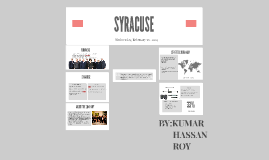Syracuse
Transcript: Archaeological Park Church of Santa Lucia Maniace Castle This church was built in 6th century and was the cathedral of Syracuse for a long period. The column remains are the only original peices left in the church. The rest of the church has overgone many changes especially after the earthquake, including the main face which was rebuilt in the Sicilian Baroque style. Roman Amphitheater Monuments found in: This is a freshwater fountain that was the peculiarity of flowing right to the seashore. Since ancient times this fountain was visited by many famous poets and writers. An ancient Greek myth says that the origin of the spring was attributed to the fate of Arethusa, who was transformed by the goddess Artemis into a spring to escape the stalking courtship of the sea god Alpheus. He too was transformed into a river (by Zeus) and mixed his water with that of Arethusa. History and Culture Church of San Giovanni (1/2) Ear of Dionysius This cathedral was built on top of the remains of the Doric Temple (5th century B.C) in Ortigia. The Duomo contains Greek, Byzantine, Arabic, and Norman influences. The main face was rebuilt in Baroque style after the earthquake in 1693. This grotto earned its name because it was where the 'cordari' (or rope-makers) carried out their work for centuries. The humid atmosphere made it easier to twist the ropes together, creating the perfect enviroment for their job. Archaeological Park (2/2) Ortigia This theater was hewn into the rock of Colle Temenite around 5th century B.C and is the largest in all of Sicily. It is considered one of the main hubs of cultural life in Syracuse. Each year several famous Greek Tragedies are played out in this wonderful theater. The Church of Santa Lucia was built in 6th century A.D where, so the legend goes, Syracuse's patron saint was tortured. Since then the church underwent several changes, especially after the earthquake. Rope-Maker's Grotto Arethusa Fountain Churches Dionysius' Ear (or The Ear of Dionysius) is a deep cave about 65 meters deep, 11 meters wide, and 23 meters high. It was built with an acute angle shaped ceiling, similar in shape to the outer ear. Thanks to this, it is well known for its special acoustics, a sound amplified up to 16 times. A famous legend says that this cave was specially built to serve as a prison for political dissidents so Dionysius could hear all their secrets and plans. a look at Syracuse Syracuse (or Siracusa) was founded in 734 B.C by Greek Colonies. 249 years later, in 485 B.C. Gelone became the first tryant of Syracuse. Eventually, the people of Syracuse rebelled against the tryant and set up a democratic government. In 413 B.C Syracuse found itself in desperate need of protection from the powerful Carthage, so the city placed itself under the protection of the tyrant Dionysius. Many years later Syracuse was conquered by the Roman Empire which caused the city's decline. In 476 A.D. the Roman Empire fell and Syracuse was later conquered by The Byzantines, the Normans, the Swabians, and the Spanish. In 1693 a tremendous earthquake shook Eastern Sicily. Syracuse was then rebuilt in the Sicilian Baroque style. Finally, in 1870, Syracuse was annexed to the Kingdom of Italy. The 'Duomo' Historical Buildings and Monuments This amphitheater was built during the Augustan period, not far from the Greek Theater. It is the 3rd largest amphitheater found in Italy, after the ones in Rome and Verona. Like the Greek Theater, it is hewn almost entirely into the rock. It was made to showcase gladiator contests, fierce animal fights and naval battle simulations. Churches Baroque Masterpieces, Ancient temples and Cathedrals Monuments found in the: Greek Theater This castle was built by Frederick || of Swabia on the far point of Ortigia. It overlooks the sea and owes its name to the Byzantine general who conquered Syracuse around the year 1000. Monuments found in the:

















